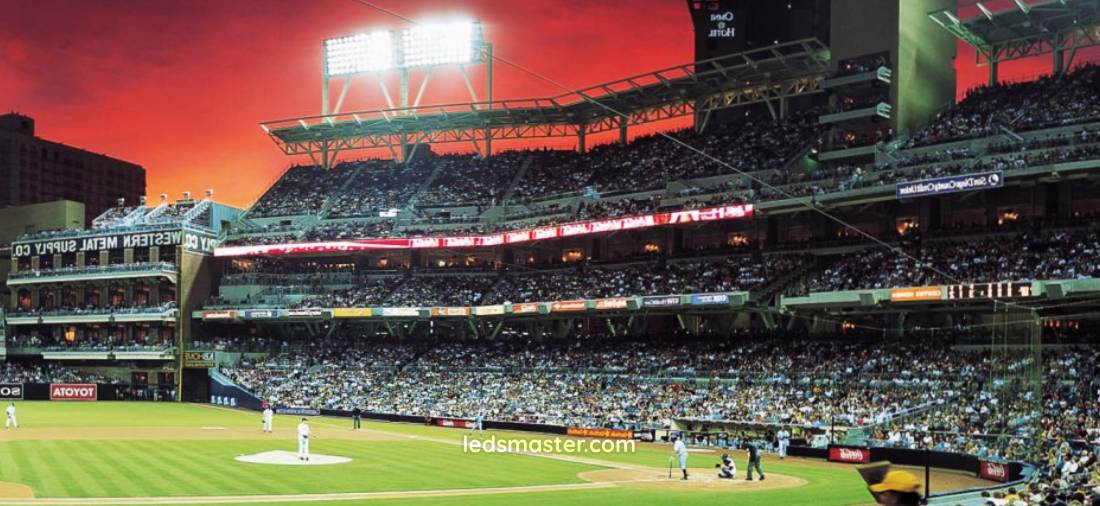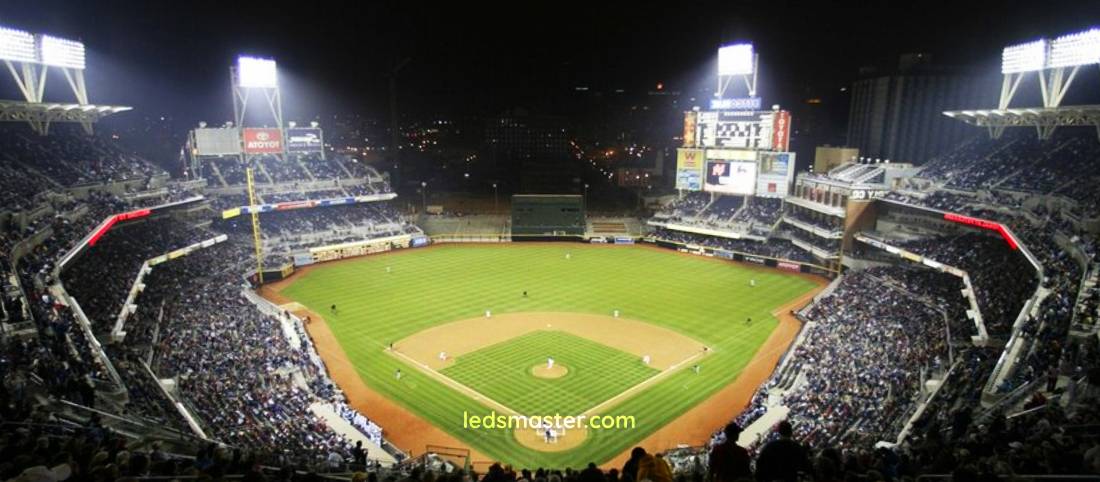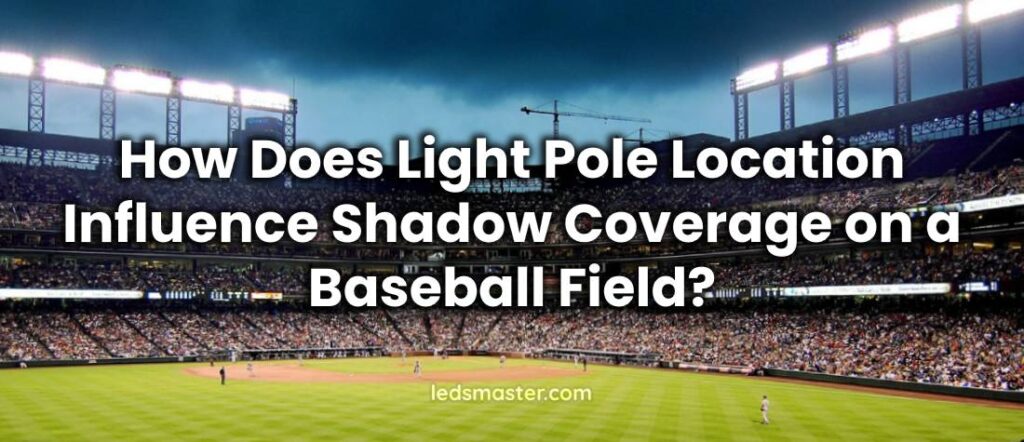The placement of light poles on a baseball field plays a defining role in ensuring optimal visibility for players, officials, and spectators. Proper lighting not only illuminates the playing area but also minimizes the formation of disruptive shadows that can interfere with gameplay. The strategic positioning, height, projection angle, and number of light poles all contribute to effective shadow management and a well-lit field.
Table of Contents
ToggleDesigning the Lighting Layout for Baseball Fields
Achieving uniform lighting on a baseball field is a complex task that requires a thorough understanding of the field’s unique layout. A baseball field consists of multiple zones, each with its own lighting needs. The infield, outfield, and foul territory must all be illuminated differently to accommodate their specific functions. Proper lighting design must not only address these differences but also ensure seamless coverage across the entire playing surface. A well-thought-out lighting layout enhances visibility, reduces distractions, and improves the overall playing and viewing experience.
The Number of Light Poles Required
The number of light poles required for a baseball field depends on several factors, including the size of the field, the level of play, and the lighting standards being followed. For professional and collegiate fields, six or eight poles are commonly used to provide adequate illumination. Recreational or youth fields, which are generally smaller, may require only four poles.
An eight-pole configuration is often preferred for larger fields because it allows for more even light distribution. With more poles, the intensity of light from each source can be lower, reducing the likelihood of harsh shadows or over-lit areas. This setup ensures that players and officials have clear visibility without the distractions of uneven lighting. By contrast, a four-pole system may create areas with insufficient brightness, particularly in the outfield or corners of the field.
Determining the Projection Angle
The projection angle of the light fixtures mounted on poles plays a significant role in controlling shadow formation. Properly calculated angles help direct light toward specific areas of the field, minimizing overlaps or dark spots. On baseball fields, light fixtures are typically angled to shine from multiple directions, ensuring comprehensive coverage.
A combination of vertical and horizontal angles is used to balance light distribution. Vertical angles are adjusted to illuminate the field’s surface, while horizontal angles target specific zones such as the pitcher’s mound or outfield. These adjustments are fine-tuned based on the height of the poles and the distance from the fixtures to the field. Properly aligned angles reduce the risk of long, sharp shadows that could hinder player performance or distract spectators.

Height of Light Poles
The height of the light poles is a defining factor in ensuring adequate field illumination. Taller poles allow light to spread over a larger area, which can significantly reduce shadow intensity. On professional baseball fields, light poles typically range from 60 to 120 feet in height. The choice of height depends on factors such as the field’s size and the level of play.
Taller poles enable lights to shine from steeper angles, which is particularly helpful for illuminating vertical elements of the game. For example, fly balls and pop-ups often rise to significant heights, and a steep light angle ensures these actions remain clearly visible. Additionally, higher poles help prevent shadows from forming in the infield and outfield by ensuring that light beams encounter fewer obstructions.
Positioning Light Poles Around the Field
The strategic placement of light poles is critical for effective shadow management. Proper positioning ensures even light distribution across the field, avoiding areas of excessive brightness or darkness. The layout of light poles is influenced by the geometry of the baseball field and the types of activities that occur during a game.
Infield Lighting
The infield is the most active area on a baseball field, with frequent plays occurring around the bases, home plate, and the pitcher’s mound. Lighting in this zone must be bright and evenly distributed to avoid shadows that could interfere with gameplay. Light poles are typically positioned behind the foul lines near the first and third baselines, angled to shine toward the infield.
This placement ensures that light covers the infield from both sides, reducing the risk of shadows being cast by players or equipment. Careful alignment of the lights ensures that areas like the pitcher’s mound remain brightly lit, allowing for optimal visibility during crucial moments of play.
Outfield Lighting
The outfield requires broader, more dispersed lighting to cover its larger area. Light poles are generally placed beyond the outfield fence, with fixtures angled to shine toward the field’s center. This arrangement minimizes overlapping shadows and ensures that fly balls and grounders are easily visible to players and spectators.
The distance from the light poles to the field is an important consideration in outfield lighting. Taller poles combined with carefully adjusted projection angles provide consistent brightness, reducing shadows along the outer edges of the field. Proper illumination of the outfield helps players track long-hit balls and enhances the viewing experience for fans.
Foul Territory and Spectator Areas
Foul territory and spectator areas are often overlooked in lighting design, but these zones are just as important for creating a well-lit field. Shadows in foul territory can affect the visibility of balls in play, while poor lighting in spectator areas can detract from the overall experience.
Light poles near the corners of the field can effectively illuminate foul territory without casting harsh shadows. Fixtures mounted on auxiliary poles or nearby structures are used to light spectator areas, such as bleachers and dugouts. These lights are typically angled to avoid spilling onto the playing surface, ensuring that the game remains the focal point of attention.

Balancing Shadows and Glare
Effective baseball field lighting requires careful attention to both shadows and glare. Shadows can obscure visibility and disrupt gameplay, while glare can cause discomfort or hinder performance. A well-designed lighting system achieves a harmonious balance between minimizing shadows and controlling glare, ensuring a comfortable and functional environment for players, officials, and spectators.
Managing Shadows and Glare Together
While reducing shadows is a primary objective, it must be done without compromising the overall lighting quality. Glare occurs when intense light is directed into the eyes of individuals on or around the field. The challenge lies in providing uniform illumination without overwhelming brightness or light spilling into unwanted areas. Thoughtful design choices and technological advancements make this balance achievable.
Using Shielded Fixtures
Shielded light fixtures are effective in directing light precisely where it is needed while minimizing spill light and glare. These fixtures are designed with built-in barriers or adjustable elements that limit the spread of light beyond the targeted areas. By focusing light beams onto the playing surface, shielded fixtures reduce the formation of unintended shadows and ensure that excess light does not create distractions.
For baseball fields, shielded fixtures are particularly helpful in preventing light from reaching the eyes of batters, outfielders, and spectators. This targeted approach improves visibility for players tracking fast-moving balls and enhances the viewing experience for fans.
Managing Light Intensity
Carefully controlling the intensity of light is critical for avoiding glare and harsh shadows. Fixtures that emit overly bright light can create hotspots or areas of uneven illumination. Conversely, dimly lit zones can produce long, sharp shadows that disrupt the flow of play.
The use of dimmers or adjustable wattage fixtures allows lighting intensity to be fine-tuned for specific conditions. For instance, lighting can be adjusted during night games or in response to changing weather. By maintaining consistent brightness across the field, soft and diffuse shadows are achieved, reducing distractions for players and officials.
Incorporating Modern Technology
Technological advancements, particularly in LED lighting, have transformed the capabilities of baseball field illumination. LED fixtures offer precise control over light distribution, allowing designers to achieve a high degree of uniformity with minimal glare.
Advantages of LED Fixtures
LED lights provide directional illumination, meaning they can be aimed with exceptional accuracy. Unlike traditional metal halide lamps, which often emit light in all directions, LEDs reduce the risk of light spilling into unwanted areas. This precision helps minimize both shadows and glare.
LED systems are also programmable, enabling dynamic adjustments to lighting conditions. For example, brightness levels can be tailored to different parts of the field or adjusted based on the time of day. These capabilities ensure consistent performance while accommodating various game scenarios.
Adapting to Changing Conditions
Modern LED systems can adapt to external factors such as weather or field usage. For example, dimming capabilities allow lights to be adjusted during cloudy conditions or when only part of the field is in use. This flexibility helps maintain optimal visibility while conserving energy.
How Standards and Guidelines Shape Practices
Standards and guidelines established by organizations such as the Illuminating Engineering Society (IES) and the International Baseball Federation provide a framework for effective lighting design. These standards ensure that baseball fields are illuminated in a way that supports safety, performance, and enjoyment.
Uniformity Ratios
Uniformity ratios are a key metric for measuring the consistency of lighting across a field. They compare the brightest and darkest areas to determine how evenly light is distributed. A lower uniformity ratio indicates more consistent illumination, which reduces both shadows and glare.
By adhering to recommended uniformity ratios, designers can create a balanced lighting environment. This involves carefully positioning light poles, adjusting fixture angles, and selecting appropriate intensities to achieve even coverage.
Compliance with Regulations
Lighting standards also address safety and performance considerations. Proper compliance ensures that fields meet the needs of players, officials, and spectators. For instance, regulations may specify minimum brightness levels, acceptable glare limits, and ideal light pole placements.
Adhering to these guidelines not only enhances the visual experience but also fosters fair play by providing consistent lighting conditions for all participants. Players are less likely to be affected by unpredictable shadows or glare, and officials can make accurate decisions without visual interference.
Designing for Balance and Performance
Balancing shadows and glare is a fundamental aspect of baseball field lighting. Shielded fixtures, controlled intensity, and modern LED technology all contribute to a lighting system that supports gameplay and enhances the viewing experience. By following established standards and guidelines, designers can create a well-lit field that meets the needs of everyone involved.
Conclusion
Thoughtful planning and design are the foundation of effective baseball field lighting. By carefully considering the number, height, projection angle, and placement of light poles, designers can create a lighting system that minimizes shadows and enhances visibility. A well-lit field allows players to perform at their best, officials to make accurate decisions, and spectators to enjoy the game without distraction.

